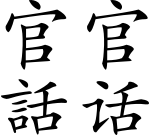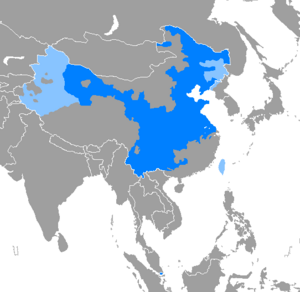Mandarin Chinese facts for kids
Quick facts for kids Mandarin |
|
|---|---|
| 官話/官话, Guānhuà | |

Guānhuà (Mandarin)
written in Chinese characters |
|
| Region | Most of Northern and Southwestern China (see also Standard Chinese) |
| Native speakers | 955 million (2010) |
| Language family | |
| Early forms: |
Old Chinese
|
| Dialects |
Northeastern
Beijing
Ji-Lu
Jiao-Liao
Lower Yangtze
Central Plains
Lan-Yin
Southwestern
Jin (sometimes a separate group)
|
| Writing system | Traditional Chinese Simplified Chinese Mainland Chinese Braille Taiwanese Braille Two-Cell Chinese Braille |
| Linguasphere | 79-AAA-b |

Mandarin area, with Jin (sometimes treated as a separate group) in light green
|
|
Mandarin Chinese, often just called Mandarin, is a very important language. It's used for government and education in most of China and Taiwan. The main exceptions are Hong Kong and Macau, where people often speak Cantonese.
Mandarin is one of China's five main regional languages. It is spoken across a huge area, from northern China all the way to Yunnan Province in the southwest. Because the area is so big, there are many differences in words. For example, someone from Beijing might not understand a person speaking the Yunnan dialect (Yunnanhua). This difference is bigger than between English speakers in Great Britain and Australia. So, in the 1920s, the Chinese government created a national language. This language is based on the Beijing dialect and uses words and pronunciations that most people can understand.
Mandarin is a standard language. This means it's not anyone's first language, but a common language that helps everyone understand each other. Even though it's based on the Beijing dialect, it's not exactly the same.
Schools teach a dialect called Standard Mandarin. In China, it's known as Putonghua (普通话/普通話), which means "common spoken language," or Hanyu (汉语/漢語), meaning "language of the Han people." In places like Malaysia, it's called Huayu (华语/華語). In Taiwan, it's known as Guoyu (国语/國語), meaning "national language." There are only small differences between these standards.
More than 800 million people worldwide speak Mandarin. This is more than any other language! Most people who move away from the Greater China region today speak Mandarin. In the past, many spoke Cantonese or Taishanese, another Chinese dialect.
Standard Mandarin is one of the six official languages used at the United Nations. The other official languages are English, French, Spanish, Russian, and Arabic.
Contents
Writing Mandarin Chinese
Mandarin is written using Chinese characters, called Hànzì (漢字 or 汉字). This name literally means "Han characters." Each Hànzì has its own sound and meaning. A typical dictionary has about 10,000 characters. Spoken Mandarin uses many compound words. These are words that combine meanings, like "playground" or "fire truck" in English.
The Hanzi characters are like idea-grams: one character often stands for one idea. You can create new ideas by combining these characters. Mandarin can also be written using the Latin alphabet, which is how English is written. This is because you can't tell how a Hanzi character is pronounced just by looking at it. Writing Chinese sounds with Latin letters is called transliteration. The most popular system for this is called Pinyin.
Some Chinese characters started as simple pictures of what they represented. Over time, people drew simpler versions that were easier to write. These simpler versions don't look as much like the real thing, similar to how you might draw a stick figure instead of a detailed person. Here are some examples:
Most characters are made by combining pictures. One picture gives a general meaning, and the other helps with the sound. For example, "媽 mā" (mom) is made by adding 女 (nǚ, female) to 馬 (mǎ, horse). The "ma" part is there just for the sound.
In older forms of Chinese, one character was usually enough for one word. But modern spoken Mandarin mostly uses compound words. For example, "媽媽 māma" means "mama."
Here are more examples of how characters combine:
- 火車 huǒ chē (literally "fire vehicle") means locomotive or train.
- 大人 dà rén (literally "big person") means adult.
- 打開 dǎ kāi (literally "strike open") means to open up (like a door or window).
Just like how English in Great Britain uses "petrol" and American English uses "gasoline," different Chinese regions might use different compound words for the same thing.
In spoken Mandarin, most words are character compounds. This is because Mandarin lost many sounds that existed in older Chinese. Because of this, many Chinese words ended up sounding the same (they became homophones). To tell them apart, more characters were added to words. For example, the Chinese title of the poem Lion-Eating Poet in the Stone Den (施氏食狮史) is pronounced "Shī Shì Shí Shī Shǐ." Every character in this poem is pronounced with the same sound, but with different tones. In older Chinese, these characters would have sounded different, making them easier to tell apart.
So, one-character words in Classical Chinese like:
| character | meaning | pinyin |
|---|---|---|
| 狮 | lion | shī |
| 筷 | chopstick(s) | kuài |
| 金 | gold/metal/money | jīn |
became longer Mandarin compound words:
| character | meaning | pinyin |
|---|---|---|
| 狮子 | lion | shīzi |
| 筷子 | chopstick(s) | kuàizi |
| 金钱 | money | jīnqián |
This helps to clearly tell these words apart from other words that sound similar, like:
| character | meaning | pinyin |
|---|---|---|
| 师 | teacher/tutor/master | shī |
| 快 | fast/quick | kuài |
| 今 | now/the present | jīn |
Without these compound words, spoken Mandarin would be much harder to understand!
Mandarin (Beijing Accent) vs. Beijing Dialect
Mandarin, the standard language, is based on the Beijing accent. China has over 600,000 dialects and many accents. Even though they all use Chinese characters, their pronunciations and some expressions are very different. China needed a standard pronunciation so everyone could understand and talk to each other. Beijing has been China's capital city for over 1,000 years. Because of this, China chose the Beijing accent as the basis for standard Mandarin.
Beijing also has its own local dialects. These are not yet part of standard Mandarin. However, since Beijing is the capital and a major center for politics, economy, culture, and education, more and more new Beijing dialect words are being accepted into standard Mandarin. Other dialects, like Shanghainese, Cantonese, or Hakka, are less likely to be included in standard Mandarin.
Here are some Beijing dialect words that are not yet standard Mandarin:
- 倍儿: bèi'ér means 'very much'
- 拌蒜: bànsuàn means 'stagger'
- 不吝: bùlìn means 'do not worry about'
- 撮: cuō means 'eat'
- 出溜: chūliū means 'slip'
- 大老爷儿们儿: dàlǎoyérmenr means 'men, males'
And here are some Beijing dialect words that have recently become accepted as standard Mandarin:
- 二把刀: èrbǎdāo means 'not very skillful'
- 哥们儿: gēmenr means 'good male friends'
- 抠门儿: kōuménr means 'parsimony' (being very careful with money)
- 打小儿: dǎxiǎo'ér means 'since childhood'
Common Mandarin Phrases
Here are some simple Mandarin phrases:
- 你好 nǐ hǎo - hello
- 你好吗?nǐ hǎo ma?- How are you?
- 我 wǒ- me, I
- 你 nǐ - you
- 您 nín - you (used to show respect, like to an elder or teacher)
Related pages
Images for kids
See also
 In Spanish: Chino mandarín para niños
In Spanish: Chino mandarín para niños


































